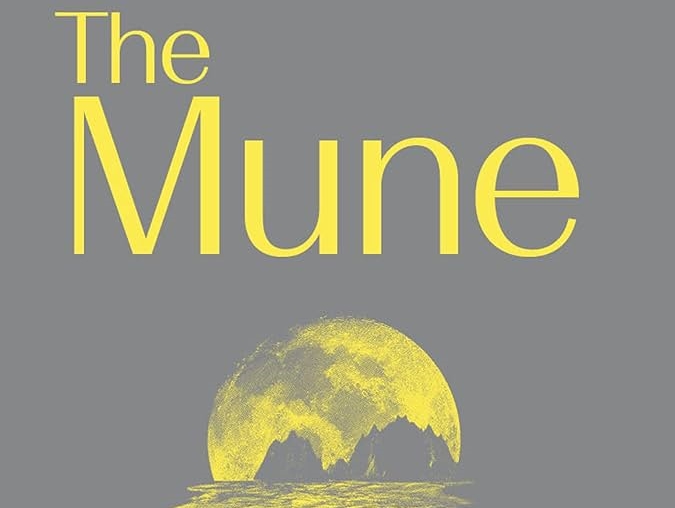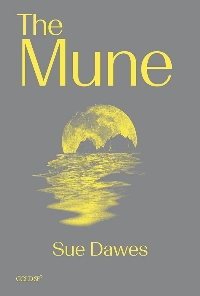Review: The Mune by Sue Dawes

I received a free copy of this book from the publisher in return for an honest review.
‘A group of Victorian women, shipwrecked on an island in a parallel universe, fight for change.
‘Thirty “surplus” mothers from asylums, workhouses, and the streets of Victorian England are shipwrecked on an island in an alternate universe. To survive, they must create a new society amid the lethal black sands and mysterious beasts.
‘How will they shake off the patriarchal chains that bound them and raise their children to be free? How will Betty, who longs to be back under the guidance of her master, survive, as the community evolves? And who is watching them?’

Disclaimer: I know the author personally, and pinky promise this is an honest and objective review.
In The Mune, by Sue Dawes, a group of “fallen” women from Victorian Britain are stranded on a strange island with their babies when the ship that’s transporting them to a new life in Australia is wrecked by a storm.
Once they’re past the initial shock, they set to work as a collective – the eponymous “Mune” – to co-ordinate shelter, food, childcare, and protection from the sealion-like creatures that pose a danger to them. Life is far from easy, but – with the exception of one island-dweller, Betty – all are happy to be free of the patriarchal prescriptions that caused them so much suffering before.
However, the island isn’t quite what it seems. On top of unlikely sources of illumination, time being on a higher speed setting, and some of the islanders displaying uncanny abilities, the old world is still out there – and there’s a way of getting back, and to other places besides, without setting foot on another boat…
A book that can be summarised as ‘a parallel universe/portal novel where a diverse group of shipwrecked Victorian women create a communist utopia and do away with the gender binary’ was always going to pique my interest, and I was already aware of Dr Dawes’ impressive ability to produce wonderfully weird and surprising stories, but even so: wow, what a read!
From the moment the characters landed there, the island captured my imagination, from the dangerous sinking sands of its shores, to its suspicious conduciveness to life (and indication that people had lived there previously) – jars that produce light when you shake them, a source of potable water, trees whose bark can be fashioned into passable clothing – to its not-quite-right-ness in terms of the passing of time.
At the same time, though, the women, and later their offspring too, have to work hard together to survive. The thrilling conflict essential to any story is provided by Betty, a former servant whose baby – fathered by her erstwhile employer – was stillborn at sea. Unlike the others, Betty refuses to make the best of things or pull her weight, and clings to the “old ways” of women’s subordination to men and Anglican expectations of gender presentation and behaviour.
Ironically, it’s Betty who first goes through the portal (inadvertently – the form the portal takes is really inventive, and means people don’t just happen across and go through it every day!) to the interstitial No Place, which is also absolutely fascinating, and the most overtly sci-fi of the novel’s three settings (the third being the Victorian world).
Other elements that particularly point up the book’s genre, sometimes ahead of it being all that clear, are the occasional short “scientific stories” that pepper the text. I’m a complete sucker for stories-within-stories anyway, but these interludes, modelled on Victorian weird fiction, delighted me, and I loved it when elements from them re-emerged in the main story further down the line.
This being Dr Dawes’ PhD novel, I naturally enjoyed drawing mental connections with other stories that share themes and styles. Along with the scientific stories, an obvious comparison for me was William Golding’s Lord of the Flies, which raised the question: was it the women’s – most of whom came from poor backgrounds – existing socialisation as responsible, nurturing helpmeets that ensured the success of the Mune, as they had a sense of resourcefulness, care, and consideration for the collective that the privileged, feckless boarding-school boys lacked?
While there are many parallel universe/portal novels out there (to which this one contributes original settings and mechanics), I was especially put in mind of Alix E. Harrow’s The Ten Thousand Doors of January – which is a good thing, as I had enjoyed it and was wanting to read more in the same vein! I made this link partly because I read The Ten Thousand Doors quite recently, so it’s still fresh in my mind, but also due to the Victorian setting, stories-within-stories element, and the differing reactions (on the whole) of contemporary men and women to the discovery of portals and unfamiliar worlds.
My only complaint is that I was left desperately wanting more. There are so many possibilities for further stories within the same universe: exploration of No Place’s origins and development; backstories of the people in No Place and/or those who lived on the island before the Mune; spin-offs about at least one of the characters who grew up in the Mune… but I also know how it feels to have completed your PhD and not want to look at or think about it ever again, so I empathise if Dr Dawes decides to keep this novel as a standalone!
The Mune is fantastically imaginative and wonderfully weird.